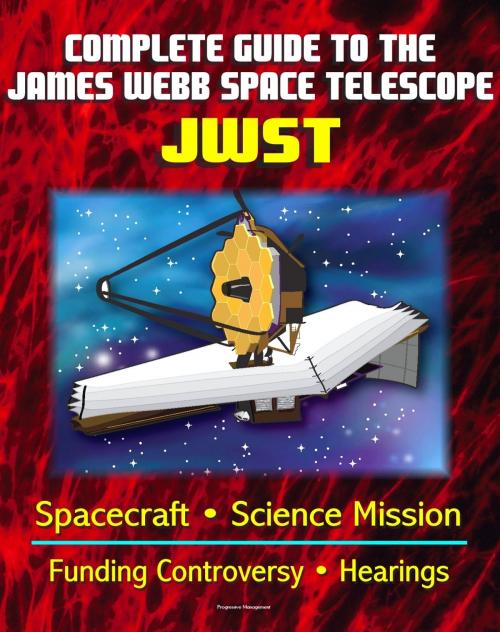Complete Guide to NASA's James Webb Space Telescope (JWST) Project - Spacecraft, Instruments and Mirror, Science, Infrared Astronomy, GAO and Independent Review Reports, Congressional Hearings
Nonfiction, Science & Nature, Science, Physics, Astronomy| Author: | Progressive Management | ISBN: | 9781465822185 |
| Publisher: | Progressive Management | Publication: | December 8, 2011 |
| Imprint: | Smashwords Edition | Language: | English |
| Author: | Progressive Management |
| ISBN: | 9781465822185 |
| Publisher: | Progressive Management |
| Publication: | December 8, 2011 |
| Imprint: | Smashwords Edition |
| Language: | English |
Comprehensive coverage of all aspects of NASA's James Webb Space Telescope (JWST), currently under construction and planned for launch sometime near 2018, is provided in this unique compilation of official NASA material. There is complete data on the JWST mission, science investigations, instruments and subsystems, unique mirror technology, the L2 orbit, special gyros, sunshield, infrared astronomy science to be obtained by the JWST, plus in-depth coverage of the funding controversy regarding the large cost overruns and schedule delays encountered by the project - with testimony from Congressional hearings, GAO reports, and the report of the Independent Comprehensive Review Panel (ICRP) along with NASA's response.
Contents: PART 1 - JWST Basic Information: Spacecraft And Science Data, Project Status Updates; PART 2 - GAO Reports On JWST; PART 3 - Independent Comprehensive Review Panel (ICRP) Final Report; PART 4 - December 2011 Congressional Hearings on JWST.
Dr. Roger Blandford noted in his testimony: JWST (formerly known as Next Generation Space Telescope) is a 6.5 meter diameter telescope. It is much larger than the Hubble Space Telescope (HST—2.4 meter diameter) and unlike HST, it will observe the universe from near the "second Lagrange Point", roughly four times as far away from the Earth as the moon but along the opposite direction to the sun. It will be protected from the sun by an elaborate sunshield. JWST is an engineering marvel and its 18 beryllium mirrors will be furled up within a rocket for launch and then deployed at its destination. This operation has to work perfectly as there will be no means of servicing it after launch.
The principal scientific goals of JWST are bold and exciting and a culmination of nearly fifty years of extraordinary discovery about the universe and our place in it. They are:
- to observe the very first stars, galaxies and black holes which formed at a time when the universe was about four percent of its present age
- to discover how stars and planets actually form today within our Galaxy
- to study planets orbiting nearby cool stars and assess their habitability
However, JWST will also operate as an astronomical observatory and many, and perhaps most, areas of astronomy will be transformed by JWST in much the same way as they have been revolutionized by HST.
JWST is specialized to observe in the infrared region of the spectrum. This is relevant because, although much light emitted by the most distant galaxies is in the optical and ultraviolet spectral bands, the wavelengths of this light are stretched roughly tenfold through the expansion of the universe into the infrared band, as we push out to greater distance and earlier times. There is a second reason why it is preferred to observe in the infrared and this is that the star-forming regions that will be intensively studied by JWST are filled with tiny grains of dust. These dust grains absorb and scatter optical and ultraviolet light but leave infrared radiation alone, enabling us to see deep inside them at these wavelengths. In addition, the light that is absorbed by dust will be re-emitted at infrared wavelengths and we can also observe the dust itself as a tell-tale tracer of star formation.
As well as being the natural successor of HST, JWST is the infrared successor of the much smaller (0.85 meter diameter) Spitzer Space Telescope, with over 50 times the light-gathering ability and 40 times the resolution as well as the Herschel telescope, led by the European Space Agency, which only observes at longer infrared wavelengths than JWST. Given this huge increase in performance over and complementarity to previous telescopes, JWST promises to be a scientific "game changer".
Comprehensive coverage of all aspects of NASA's James Webb Space Telescope (JWST), currently under construction and planned for launch sometime near 2018, is provided in this unique compilation of official NASA material. There is complete data on the JWST mission, science investigations, instruments and subsystems, unique mirror technology, the L2 orbit, special gyros, sunshield, infrared astronomy science to be obtained by the JWST, plus in-depth coverage of the funding controversy regarding the large cost overruns and schedule delays encountered by the project - with testimony from Congressional hearings, GAO reports, and the report of the Independent Comprehensive Review Panel (ICRP) along with NASA's response.
Contents: PART 1 - JWST Basic Information: Spacecraft And Science Data, Project Status Updates; PART 2 - GAO Reports On JWST; PART 3 - Independent Comprehensive Review Panel (ICRP) Final Report; PART 4 - December 2011 Congressional Hearings on JWST.
Dr. Roger Blandford noted in his testimony: JWST (formerly known as Next Generation Space Telescope) is a 6.5 meter diameter telescope. It is much larger than the Hubble Space Telescope (HST—2.4 meter diameter) and unlike HST, it will observe the universe from near the "second Lagrange Point", roughly four times as far away from the Earth as the moon but along the opposite direction to the sun. It will be protected from the sun by an elaborate sunshield. JWST is an engineering marvel and its 18 beryllium mirrors will be furled up within a rocket for launch and then deployed at its destination. This operation has to work perfectly as there will be no means of servicing it after launch.
The principal scientific goals of JWST are bold and exciting and a culmination of nearly fifty years of extraordinary discovery about the universe and our place in it. They are:
- to observe the very first stars, galaxies and black holes which formed at a time when the universe was about four percent of its present age
- to discover how stars and planets actually form today within our Galaxy
- to study planets orbiting nearby cool stars and assess their habitability
However, JWST will also operate as an astronomical observatory and many, and perhaps most, areas of astronomy will be transformed by JWST in much the same way as they have been revolutionized by HST.
JWST is specialized to observe in the infrared region of the spectrum. This is relevant because, although much light emitted by the most distant galaxies is in the optical and ultraviolet spectral bands, the wavelengths of this light are stretched roughly tenfold through the expansion of the universe into the infrared band, as we push out to greater distance and earlier times. There is a second reason why it is preferred to observe in the infrared and this is that the star-forming regions that will be intensively studied by JWST are filled with tiny grains of dust. These dust grains absorb and scatter optical and ultraviolet light but leave infrared radiation alone, enabling us to see deep inside them at these wavelengths. In addition, the light that is absorbed by dust will be re-emitted at infrared wavelengths and we can also observe the dust itself as a tell-tale tracer of star formation.
As well as being the natural successor of HST, JWST is the infrared successor of the much smaller (0.85 meter diameter) Spitzer Space Telescope, with over 50 times the light-gathering ability and 40 times the resolution as well as the Herschel telescope, led by the European Space Agency, which only observes at longer infrared wavelengths than JWST. Given this huge increase in performance over and complementarity to previous telescopes, JWST promises to be a scientific "game changer".















